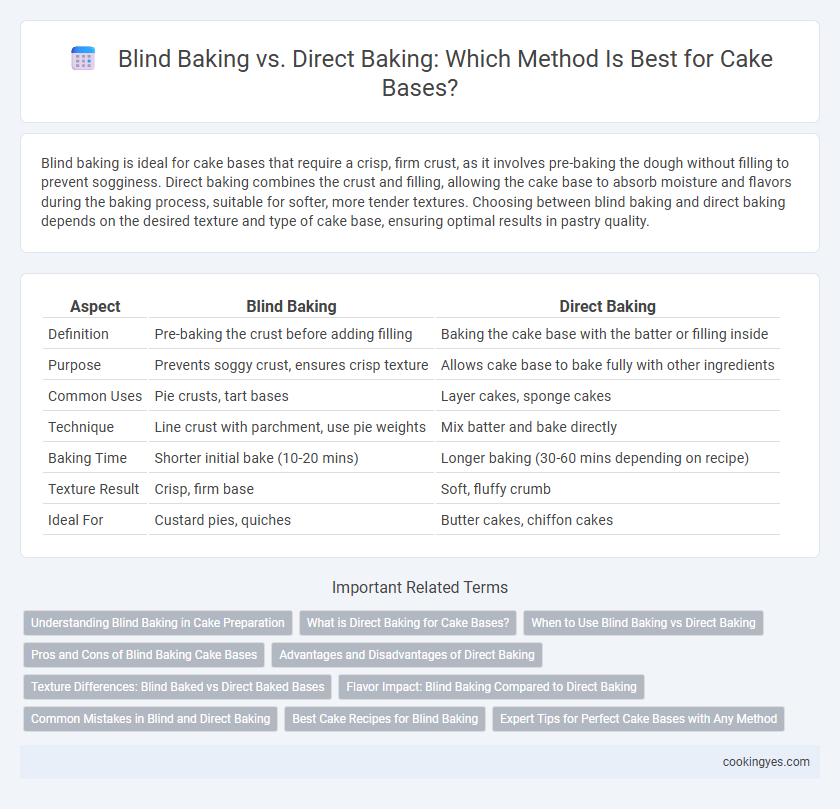Blind baking is ideal for cake bases that require a crisp, firm crust, as it involves pre-baking the dough without filling to prevent sogginess. Direct baking combines the crust and filling, allowing the cake base to absorb moisture and flavors during the baking process, suitable for softer, more tender textures. Choosing between blind baking and direct baking depends on the desired texture and type of cake base, ensuring optimal results in pastry quality.
Table of Comparison
| Aspect | Blind Baking | Direct Baking |
|---|---|---|
| Definition | Pre-baking the crust before adding filling | Baking the cake base with the batter or filling inside |
| Purpose | Prevents soggy crust, ensures crisp texture | Allows cake base to bake fully with other ingredients |
| Common Uses | Pie crusts, tart bases | Layer cakes, sponge cakes |
| Technique | Line crust with parchment, use pie weights | Mix batter and bake directly |
| Baking Time | Shorter initial bake (10-20 mins) | Longer baking (30-60 mins depending on recipe) |
| Texture Result | Crisp, firm base | Soft, fluffy crumb |
| Ideal For | Custard pies, quiches | Butter cakes, chiffon cakes |
Understanding Blind Baking in Cake Preparation
Blind baking involves pre-baking a cake base without filling to prevent sogginess and maintain structural integrity, especially for moist or custard-filled cakes. This technique uses parchment paper and baking weights to keep the dough flat and even during baking. Understanding blind baking enhances the texture and stability of cake crusts, ensuring crispness and preventing shrinkage.
What is Direct Baking for Cake Bases?
Direct baking for cake bases involves baking the batter immediately without pre-baking or partially baking the crust, allowing the cake to rise and cook evenly within the mold. This method is ideal for soft, airy cake bases like sponge or genoise that rely on batter aeration rather than a firm crust. Unlike blind baking, direct baking eliminates the need to pre-cook a crust, reducing preparation time and preserving moisture within the cake base.
When to Use Blind Baking vs Direct Baking
Blind baking is essential for cake bases with wet or custard fillings to prevent sogginess by pre-baking the crust, ensuring it remains crisp and fully cooked. Direct baking suits cake bases where the filling and crust cook simultaneously, typical for fruit pies or tarts with dry or partially cooked fillings. Choose blind baking for delicate, moisture-rich fillings and direct baking for compact, evenly combined ingredients.
Pros and Cons of Blind Baking Cake Bases
Blind baking cake bases ensures a crisp, leak-proof crust ideal for custard or cream toppings, preventing sogginess often caused by wet fillings. It requires the use of pie weights or beans to avoid puffing, which can be time-consuming and may risk over-browning if not monitored carefully. Direct baking saves time but can lead to a softer, less structurally stable base, especially with moist fillings, making blind baking preferable for certain recipes.
Advantages and Disadvantages of Direct Baking
Direct baking for cake bases offers the advantage of faster preparation by eliminating the need for pre-baking the crust, resulting in a tender and moist texture that blends seamlessly with fillings. However, this method may cause uneven baking, leading to soggy or undercooked edges due to moisture from liquid fillings failing to evaporate properly. Cakes baked directly might also lack the structural crispness provided by blind baking, affecting the overall texture and stability of layered desserts.
Texture Differences: Blind Baked vs Direct Baked Bases
Blind baking cake bases produces a firmer, crisper texture as the dough cooks thoroughly without the moisture of the filling, preventing sogginess and ensuring a sturdy foundation. Direct baking allows the base to absorb moisture from the batter or filling, resulting in a softer, more tender crumb but a less rigid structure. Choosing between blind baked and direct baked bases impacts whether the cake foundation maintains its crispness or blends more harmoniously with the filling's texture.
Flavor Impact: Blind Baking Compared to Direct Baking
Blind baking enhances flavor development by allowing the crust to cook thoroughly and develop a toasted, nutty aroma before filling addition. Direct baking often results in a moister, less intense crust that can dilute the base's flavor profile. The Maillard reaction during blind baking intensifies taste, providing a richer, more complex foundation for cakes.
Common Mistakes in Blind and Direct Baking
Common mistakes in blind baking cake bases include underweighting pie weights, which leads to puffing and uneven surfaces, and failing to prick the dough, causing air bubbles. In direct baking, overmixing the batter results in dense, tough textures, while incorrect oven temperatures cause uneven rising and soggy centers. Proper technique and attention to details like docking and temperature control are crucial for flawless cake bases.
Best Cake Recipes for Blind Baking
Blind baking ensures a crisp, non-soggy cake base essential for custard or cream fillings, achieved by pre-baking the crust with baking weights or beans to maintain shape. Best cake recipes for blind baking include tart shells and shortcrust pastry cakes that require a firm foundation before adding wet ingredients. These recipes prioritize even heat distribution and precise timing for a perfectly baked crust that complements delicate fillings.
Expert Tips for Perfect Cake Bases with Any Method
Blind baking ensures a crisp, sturdy cake base by pre-baking the crust with weights to prevent puffing or shrinking, ideal for wet or custard fillings. Direct baking skips pre-baking, relying on batter moisture and oven heat to cook the base simultaneously, best suited for sturdy batters that won't become soggy. Experts recommend chilling dough before blind baking and using parchment paper with pie weights for even cooking, while for direct baking, selecting recipes with balanced moisture and optimal oven temperature avoids undercooked or dense bases.
Blind Baking vs Direct Baking for cake bases Infographic

 cookingyes.com
cookingyes.com